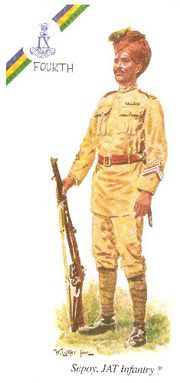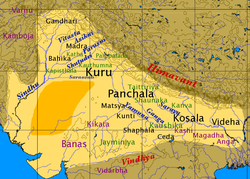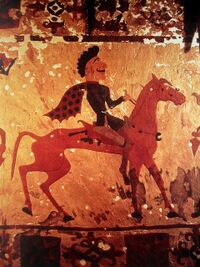Samar Rathi
Senior Member
- Joined
- May 11, 2013
- Messages
- 1,001
- Likes
- 1,211
The Jat people (Jat: जाट, also spelt Jatt: जट्ट), are a 33 million strong ethnic group of people[1][2] native to South Asia in mainly the Punjab region of India and Pakistan. Other regions include Balochistan, NWFP, Rajasthan, Haryana, Uttar Pradesh, Madhya Pradesh, Gujarat,Maharashtra. They are a ethnic group, race, tribe and a people.[3][4][5][6] James Tod places it in the list of Thirty Six Royal Races.[7]
The Jat people are considered to be the merged descendants of Indo-Aryans, Indo-Scythian tribes of the region, merging to form the Jat people.[8]
An uninformed view is that Jat is a farmer-caste (caste = social group) but Jat is really a race (race = ethnic group). Only a subset of the over 900 million farmers in south Asia are Jats. There are specific Jat DNA markers in the genetic profile, as highlighted in the Jat Genetics section.
The Jat people follow different faiths and are engaged in different professions. They have a discrete and distinct cultural history that can be historically traced back to ancient times.[9][10]
The Jat people were designated by the British Empire as a Martial Race. Martial Races were races & peoples that were naturally warlike and aggressive in battle, and possess qualities like courage, loyalty, self sufficiency, physical strength, resilience, orderliness, hard working, fighting tenacity and military strategy. The British Empire recruited heavily from these Martial Races for service in their Armies. A strategy that is still used today (21st century) in Armies of South Asian countries e.g. The famous Jat Regiment & the Gurkhas.
It would be relevant to know the core concepts of Jat people, their culture and history. Read Learning Jat people's history to understand why Jat people regard it is so important to understand their culture and history.
People

The Jat Regiment Battle Insignia
Col. James Tod notes that The Jats hold place amongst the 36 Royal Races of ancient India.[11][12][13][14] Some historians consider Jats, along with Kayasthas and Gujars, out of purview of varna system.[15] The Jat people are an ethnic group[16][17][18] spread over Northern India andPakistan (mainly in the Punjab region).[19], but also including large numbers living in the EU, US, Canada, Australia and UK. The Jat people have traditionally been mainly agriculturalists and members of the military. Historically, there have been many Jat kings and other leading figures,[20]including several prominent political leaders in Pakistan and India, such as Chaudhary Charan Singh, Chaudhary Bansi Lal, Chaudhari Devi Lal,Aitzaz Ahsan and Chaudhry Pervaiz Elahi. This includes American Senator Satveer Chaudhary (the first South Asian senator in American history).[21]
A large number of Jats have served in the Indian Army and Pakistan Army, including in the Jat Regiment, Sikh Regiment, Rajputana Rifles and the Grenadiers, where they have won many of the highest military awards for gallantry and bravery. The Jat Regiment is one of the longest serving and most decorated infantry regiments of the Indian Army[22] having won 24 battle honours between 1839 and 1947, along with numerous decorations of individual members.[23] Jat people in the Pakistan Army, especially in the Punjab Regiment (Pakistan), have also been highly decorated and won medals of the highest orders or bravery.
The Jat people are one of the most prosperous groups in India on a per-capita basis (Punjab, Haryana, and Gujarat are the wealthiest of Indian states).[24] Traditionally they have been a predominant political class in Punjab.[25]
People Demographics

The Jat People Religious Demographic

The Jat People are mainly concentrated in the greaterPunjab region
The Punjab region is the old land which includes Haryana, Himachal Pradesh, Delhi, Punjab State and Pakistan Punjab province

South Asian map distribution of Jat people. Jat people, in South Asia, are mostly concentrated in the greater Punjab region
The census in 1931 in India recorded population on the basis of ethnicity. In 1925, according to Professor Qanungo[26] the population of Jatts was around nine million in South Asia and was made up of followers of three major religions as shown below.
Religion Jat Population %
Hinduism 47%
Sikhism 20%
Islam 33%
Professor B.S. Dhillon, states by taking population statistical analysis into consideration the Jatt population growth of both India and Pakistan since 1925, Professor Quanungo's figure of nine million could be translated into a minimum population statistic (1988) of 30 million.[27]
According to earlier census reports, the Jati or Jat people accounted for approximately 25% of the entire Sindhi-Punjabi speaking area, making it the one of "largest single socially distinctive group" in the region.[28]
Hukum Singh Pawar (Pauria) states, adequate statistics about Jat people population are available in the Census Report of India of 1931, which is the last and the most comprehensive source of information on the Jat people, who were estimated to be approximately ten million in number at that time.[29] From 1931 to 1988 the estimated increase in the Jat people population of the Indian subcontinent
including Pakistan respectively is 3.5% Hindu, 3.5% Sikh and 4.0% Muslim.[30] Dr Sukhbir Singh estimates that the population of Hindu Jatts, numbered at 2,210,945 in the 1931 census, rose to about 7,738,308 by 1988, whereas Muslim Jatts, numbered at 3,287,875 in 1931, would have risen to about 13,151,500 in 1988. The total population of Jatts was given as 8,406,375 in 1931, and estimated to have been about 31,066,253 in 1988.
The region-wise break-up of the total Jatt people population (including the Jat Hindu, Jat Sikh and Jat Muslim) is given in the following table. The Jat people, approximately 73%, are located mainly in the Punjab region:[31]

Military & Political People

A Jat Infantry Soldier
A large number of Jatt people serve in the Indian Army, including the Jat Regiment, Sikh Regiment, Rajputana Rifles and the Grenadiers, where they have won many of the highest military awards for gallantry and bravery. Jat people also serve in the Pakistan Army especially in the Punjab Regiment, where they have also been highly decorated. The Jat Regiment is an infantry regiment of the Indian Army, it is one of the longest serving and most decorated regiments of the Indian Army[32]. The regiment has won 19 battle honours between 1839 to 1947[33] and post independence 5 battle honours, eight Mahavir Chakra, eight Kirti Chakra, 32 Shaurya Chakras, 39 Vir Chakras and 170 Sena medals[34] Major Hoshiar Singh of Rohtak won the Paramvir Chakra during Indo-Pak war of 1971. Rohtak district, which has a high density of Jat people, has the distinction of producing the highest number of Victoria Cross winners of any district in India.

A WW1 (1914-1918) Jat Army Officer's Brass Button - from the famous 9th Jat Regiment an elite-fighting Unit of the Jat Regiment
The Jat people were designated by British officials as a "Martial Race". "Martial Race" was a designation created by officials of British India to describe "races" (peoples) that were thought to be naturally warlike and aggressive in battle, and to possess qualities like courage, loyalty, self sufficiency, physical strength, resilience, orderliness, hard working, fighting tenacity and military strategy. The British recruited heavily from these Martial Races for service in the colonial army.[35]
Traditionally they have dominated as the political class in Punjab.[36]
A number of Jat people belonging to the political classes have produced many political leaders, including the 6th Prime Minister of India, Prime Minister Chaudhary Charan Singh. Moreover, there have been many Jat Kings and warriors throughout history.[37]
The Jat people are one of the most prosperous groups in India on a per-capita basis (Punjab, Haryana, and Gujarat are the wealthiest of Indian states).[38]
The Jat people are considered to be the merged descendants of Indo-Aryans, Indo-Scythian tribes of the region, merging to form the Jat people.[8]
An uninformed view is that Jat is a farmer-caste (caste = social group) but Jat is really a race (race = ethnic group). Only a subset of the over 900 million farmers in south Asia are Jats. There are specific Jat DNA markers in the genetic profile, as highlighted in the Jat Genetics section.
The Jat people follow different faiths and are engaged in different professions. They have a discrete and distinct cultural history that can be historically traced back to ancient times.[9][10]
The Jat people were designated by the British Empire as a Martial Race. Martial Races were races & peoples that were naturally warlike and aggressive in battle, and possess qualities like courage, loyalty, self sufficiency, physical strength, resilience, orderliness, hard working, fighting tenacity and military strategy. The British Empire recruited heavily from these Martial Races for service in their Armies. A strategy that is still used today (21st century) in Armies of South Asian countries e.g. The famous Jat Regiment & the Gurkhas.
It would be relevant to know the core concepts of Jat people, their culture and history. Read Learning Jat people's history to understand why Jat people regard it is so important to understand their culture and history.
People

The Jat Regiment Battle Insignia
Col. James Tod notes that The Jats hold place amongst the 36 Royal Races of ancient India.[11][12][13][14] Some historians consider Jats, along with Kayasthas and Gujars, out of purview of varna system.[15] The Jat people are an ethnic group[16][17][18] spread over Northern India andPakistan (mainly in the Punjab region).[19], but also including large numbers living in the EU, US, Canada, Australia and UK. The Jat people have traditionally been mainly agriculturalists and members of the military. Historically, there have been many Jat kings and other leading figures,[20]including several prominent political leaders in Pakistan and India, such as Chaudhary Charan Singh, Chaudhary Bansi Lal, Chaudhari Devi Lal,Aitzaz Ahsan and Chaudhry Pervaiz Elahi. This includes American Senator Satveer Chaudhary (the first South Asian senator in American history).[21]
A large number of Jats have served in the Indian Army and Pakistan Army, including in the Jat Regiment, Sikh Regiment, Rajputana Rifles and the Grenadiers, where they have won many of the highest military awards for gallantry and bravery. The Jat Regiment is one of the longest serving and most decorated infantry regiments of the Indian Army[22] having won 24 battle honours between 1839 and 1947, along with numerous decorations of individual members.[23] Jat people in the Pakistan Army, especially in the Punjab Regiment (Pakistan), have also been highly decorated and won medals of the highest orders or bravery.
The Jat people are one of the most prosperous groups in India on a per-capita basis (Punjab, Haryana, and Gujarat are the wealthiest of Indian states).[24] Traditionally they have been a predominant political class in Punjab.[25]
People Demographics

The Jat People Religious Demographic

The Jat People are mainly concentrated in the greaterPunjab region
The Punjab region is the old land which includes Haryana, Himachal Pradesh, Delhi, Punjab State and Pakistan Punjab province

South Asian map distribution of Jat people. Jat people, in South Asia, are mostly concentrated in the greater Punjab region
The census in 1931 in India recorded population on the basis of ethnicity. In 1925, according to Professor Qanungo[26] the population of Jatts was around nine million in South Asia and was made up of followers of three major religions as shown below.
Religion Jat Population %
Hinduism 47%
Sikhism 20%
Islam 33%
Professor B.S. Dhillon, states by taking population statistical analysis into consideration the Jatt population growth of both India and Pakistan since 1925, Professor Quanungo's figure of nine million could be translated into a minimum population statistic (1988) of 30 million.[27]
According to earlier census reports, the Jati or Jat people accounted for approximately 25% of the entire Sindhi-Punjabi speaking area, making it the one of "largest single socially distinctive group" in the region.[28]
Hukum Singh Pawar (Pauria) states, adequate statistics about Jat people population are available in the Census Report of India of 1931, which is the last and the most comprehensive source of information on the Jat people, who were estimated to be approximately ten million in number at that time.[29] From 1931 to 1988 the estimated increase in the Jat people population of the Indian subcontinent
including Pakistan respectively is 3.5% Hindu, 3.5% Sikh and 4.0% Muslim.[30] Dr Sukhbir Singh estimates that the population of Hindu Jatts, numbered at 2,210,945 in the 1931 census, rose to about 7,738,308 by 1988, whereas Muslim Jatts, numbered at 3,287,875 in 1931, would have risen to about 13,151,500 in 1988. The total population of Jatts was given as 8,406,375 in 1931, and estimated to have been about 31,066,253 in 1988.
The region-wise break-up of the total Jatt people population (including the Jat Hindu, Jat Sikh and Jat Muslim) is given in the following table. The Jat people, approximately 73%, are located mainly in the Punjab region:[31]

Military & Political People

A Jat Infantry Soldier
A large number of Jatt people serve in the Indian Army, including the Jat Regiment, Sikh Regiment, Rajputana Rifles and the Grenadiers, where they have won many of the highest military awards for gallantry and bravery. Jat people also serve in the Pakistan Army especially in the Punjab Regiment, where they have also been highly decorated. The Jat Regiment is an infantry regiment of the Indian Army, it is one of the longest serving and most decorated regiments of the Indian Army[32]. The regiment has won 19 battle honours between 1839 to 1947[33] and post independence 5 battle honours, eight Mahavir Chakra, eight Kirti Chakra, 32 Shaurya Chakras, 39 Vir Chakras and 170 Sena medals[34] Major Hoshiar Singh of Rohtak won the Paramvir Chakra during Indo-Pak war of 1971. Rohtak district, which has a high density of Jat people, has the distinction of producing the highest number of Victoria Cross winners of any district in India.

A WW1 (1914-1918) Jat Army Officer's Brass Button - from the famous 9th Jat Regiment an elite-fighting Unit of the Jat Regiment
The Jat people were designated by British officials as a "Martial Race". "Martial Race" was a designation created by officials of British India to describe "races" (peoples) that were thought to be naturally warlike and aggressive in battle, and to possess qualities like courage, loyalty, self sufficiency, physical strength, resilience, orderliness, hard working, fighting tenacity and military strategy. The British recruited heavily from these Martial Races for service in the colonial army.[35]
Traditionally they have dominated as the political class in Punjab.[36]
A number of Jat people belonging to the political classes have produced many political leaders, including the 6th Prime Minister of India, Prime Minister Chaudhary Charan Singh. Moreover, there have been many Jat Kings and warriors throughout history.[37]
The Jat people are one of the most prosperous groups in India on a per-capita basis (Punjab, Haryana, and Gujarat are the wealthiest of Indian states).[38]















